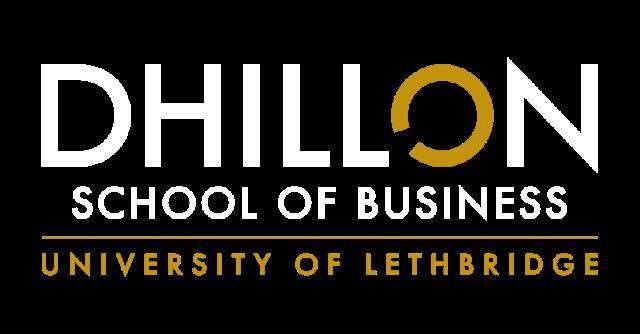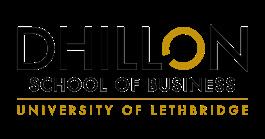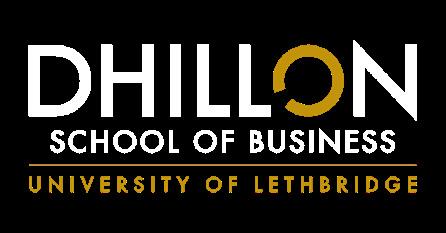






Congratulations to all on another successful year of research and scholarship in the Dhillon School of Business. As you’ll see in this annual report, our work has been published in quality peer-reviewed journals, at national and international conferences, in books and many other forms of scholastic outlets. Our research and scholarship has contributed to the development of further knowledge and understanding across a range of fields and disciplines in accounting and finance, human resources and organizational behaviour, marketing, strategy and international management to name a few.
We are very pleased to share these accomplishments with you and look forward to the future work from the Dhillon School of Business research community. If you are interested in learning more about our research or exploring collaborations with your organization, please contact dhillon.dean@uleth.ca






We investigate the use of home equity to address the retirement saving crisis and funding shortfall. Using survey data from consumers and financial planners, we examine Canadian consumers’ views on equity release and gauge financial planners’ knowledge, attitudes and perspectives towards recommending equity release products to their clients. Our findings indicate that a primary barrier for consumers is their lack of understanding about home equity release schemes. However, when these schemes are more cost-effective and endorsed by financial planners, they become more attractive. Behavioral biases and emotional attachment to one’s home did not affect consumers’ willingness when considering these options. Among financial planners, there’s a general comfort in advising on home equity release. Their preferred recommendation is the “sell and downsize” strategy, followed by HELOC. Interestingly, older planners and those with personal biases tend to be more hesitant in giving advice on this subject. The results of this study suggest there may be a willingness to access home equity by future retirees and that there is less desire to bequeath assets to the next generation.
Full citation: Baulkaran, V., & Jain, P. (2024). Home equity and retirement funding: Challenges and opportunities. Global Finance Journal, 100969.
We examine whether financial planners display common behavioral biases and whether these biases affect their recommendations for various home equity release options to fund retirement income. First, we show that different factors explain different behavioral biases. Second, we show that different behavioral biases affect financial planners’ comfort level and recommendations for various options to fund extra income during retirement. For instance, female planners, planners with advanced degrees and those from non-bank institutions display less mental accounting bias, while older and high-income planners display lower loss aversion. Specifically, our findings reveal that biases, notably mental accounting and herding, influence planners’ willingness to recommend home equity utilization. Furthermore, these biases significantly affect the ranking of retirement income strategies. Planners exhibiting mental accounting or gambler’s fallacy prioritize selling investments, whereas those with loss aversion lean toward selling and downsizing. Our findings have important implications for financial planning and advising practices as they illuminate the nuanced interplay between planner biases and advisory practices in retirement planning.
Full citation: Baulkaran, V., & Jain, P. (2024). Behavioral biases of financial planners: The case of retirement funding recommendations. Journal of Behavioral Finance, 1-14.


This paper examines theoretically and empirically a variance-dependent pricing kernel in the continuous-time two-factor stochastic volatility (SV) model. We investigate the relevance of such a kernel in the joint modeling of index returns and option prices. We contrast the pricing performance of this model in capturing the term structure effects and smile/smirk patterns to discrete-time GARCH models with similar variance-dependent kernels. We find negative and significant risk premium for both volatility factors, implying that investors are willing to pay for insurance against increases in volatility risk, even if it has little persistence. In-sample, the component GARCH model exhibits a slightly better fit overall and across all maturity buckets than the two-factor SV model. However, the two-factor SV model reduces strike price bias, giving rise to the model’s ability in reconciling the physical and riskneutral distribution. Out-of-sample, the two-factor SV model has better fit to data.
Full citation: Ghanbari, H. (2024). Persistent and transient variance components in option pricing models with variance-dependent Kernel. Journal of Empirical Finance, 79, 101531.

We propose a two-country model with heterogeneous beliefs to understand dynamics of nominal exchange rate. Facing a shock to monetary policy, disagreement between domestic and foreign investors shifts the relative wealth of investors – an essential part of the stochastic discount factor in our model – which then moves the foreign exchange rate. Calibrated to U.S. and U.K. data, our model reveals that dispersion in beliefs predicts the future spot exchange rate, associates with the cross-section of currency risk premia and comoves with the time-varying volatility in currency returns. Furthermore, our model suggests that domestic investors would hold fewer foreign currency-denominated bonds in countries with greater disagreements on monetary policy.
Full citation: Croitoru, B., Jiao, F., & Lu, L. (2024). Nominal exchange rates and heterogeneous beliefs. Journal of Economic Dynamics and Control, 166, 104904.


We investigate whether social capital and trust provide a form of liquidity/trading resilience. More specifically, whether social capital and trust played a role in the speed of stock recovery following activation of the market-wide circuit breaker (MWCB) that occurred at the beginning of the COVID-19 pandemic in March 2020. Our finding that high-social capital firms rebounded more swiftly in terms of stock liquidity and quality of the stock trading environment provides new evidence that social capital and trust can safeguard firms’ stocks against a potential liquidity drain and rapid deterioration in the stock trading environment under extreme market conditions.
Full citation: Faff, R., Huang, J., Shao, P., Xiao, Y., & Zhou, F. (2024). Does social capital enhance stock liquidity? An investigation of the resilience of the trading environment during a crisis of trust. Abacus, 60(3), 627-664.
When a firm’s loans are first traded in the secondary market, private information about the firm is disclosed to a select group of large investors, so-called qualified institutional buyers (QIBs). We document a significant information effect that benefits these buyers in the firm’s market for equity, in particular, a significant impact on equity market investors and the firm’s stock bid-ask spreads, which benefits informed QIBs relative to retail investors. This informational benefit raises important regulatory issues related to disclosure and SEC regulations.
Full citation: Saunders, A., Shao, P., & Xiao, Y. (2024). Private information disclosure in the secondary loan market and its impact on equity market trading costs. Journal of Financial Markets, 67, 100867.


Two critical questions arise in the context of mounting pressures to reduce carbon emissions from freight transportation. Is it possible to reconcile the emissions reductions goals of shippers and logistics service providers (LSPs)? How do factors such as consumer preferences, eco-efficiency, carbon tax policy and sharing of green investment cost affect target emissions levels? We address these questions using game theory to model shippers and LSPs as economic agents, thereby gaining insight into how the carbon intensity of freight delivery operations can be reduced. Our novel contributions include (1) models that consider both the shipper’s and the LSP’s interests, and in particular the gap between their preferred environmental performance levels; and (2) a methodologically rigorous explanation why, as empirical studies suggest, LSPs and shippers rarely agree on how to share responsibility for environmental initiatives, or who should pay a carbon tax.
Full citation: Jourabchi, S. M., Kilgour, D. M., Haughton, M., & Araghi, M. (2024). Environmental goal misalignment between logistics service providers and shippers: An analytical perspective. Cleaner Logistics and Supply Chain, 11, 100145.


Bahareh
Sedghy
Organic farming and short food supply chains have gained considerable attention as the key contributors of sustainability to agricultural practices. Despite the significant existing literature on these two research realms, the competition between short and retail channels for organic products has not yet been examined. In this study, we consider an organic food supply chain consisting of two farmers, where the traditional farmer sells his organic products through a retail channel and the local farmer sells his organic products through a short channel. Using real-world data, we first empirically estimate the demand function of organics in the retail and short channels while analyzing the characteristics of these functions. Having estimated the demand functions, we then study the supply chain problem analytically based on a game-theoretic leaderfollower Stackelberg model. We find the optimal closed-form solutions for quantities and prices by maximizing profit functions. The results indicate that consumers are willing to pay a premium for organic products in the short channel. Additionally, the empirical findings reveal short and retail channels engaging in price competition, higher transition from the retailer network to the short channel and greater producer market power in the latter. The sensitivity analysis indicates that an increase in the cultivation area leads to an increase in the quantity of production in both channels and wholesale prices but a decrease in consumer prices. However, an increase in linear cost factor leads to a reduction in the quantity of production in the retail channel, along with an increase in the consumer prices and quantity of production in the short channel. Our findings also reveal valuable implications for retailers and farmers supplying their products in short food supply chains. The results indicate that retailers must monitor the prices in the short channel and keep price stability relative to this channel. Finally, we offer managerial guidance to farmers within the short channel to enhance the channel’s performance.
Full citation: Sedghy, B. M., Nematollahi, M., & Tajbakhsh, A. (2024). Market dynamics between retail channels and short food supply chains: a case of organic fruits. Journal of Retailing and Consumer Services, 79, 103775.


Postural orthostatic tachycardia syndrome (POTS) is a chronic form of orthostatic intolerance that primarily affects female patients. Despite the severity of POTS, there are no approved medications for use in patients with this disorder. Compression garments are a commonly prescribed nonpharmacological treatment, but little is known about the patient experience with compression. In this study we aimed to evaluate the patient experience with compression garments using a structured survey and semistructured telephone interviews. A focused survey was designed as a component of a larger clinical trial on compression garment use in patients diagnosed with POTS. Building on the survey, semistructured telephone interviews were conducted with POTS patients. Recorded interviews were transcribed and coded in a thematic analysis using a descriptive-interpretive approach. A total of 27 participants completed the survey and 20 participants completed the telephone interview. Patient experiences with compression were variable, with some participants experiencing significant benefits, and others reporting minimal to no benefits. Six themes that influenced garment use were identified: the potential benefit of the garment to improve symptoms, specific activities patients will be undertaking, environmental conditions, garment attributes, psychological and cognitive aspects, and financial considerations. Participants engage in a daily cost-benefit analysis when making decisions to use a compression garment. Clinicians should be aware of the benefits of and factors that limit use of compression garments as a treatment for POTS.
Full citation: Bourne, K. M., Sheldon, R. S., Exner, D. V., Runte, M., & Raj, S. R. (2024). One size does not fit all: An exploration of compression garment use in patients with postural orthostatic tachycardia syndrome. CJC open, 6(11), 1324-1333.


Donald McIntyre
The impetus for this paper emerges from the growing interest in leveraging inner transformations to support a global shift in ways of seeing and being. We caution that without sufficient individual and systemic maturity, inner transformations will be unable to hold the whole story and that attempts to drive paradigmatic shifts in ill-prepared systems will lead to insidious harms. As such, interventions for inner change will not have sufficient protected niche space to move beyond the boundaries of best practices towards wise practices. Drawing on Indigenous trans-systemics, we offer the metaphor of pearls as an invitation to recontextualize how inner transformations are conceived and approached in the metacrisis. To further develop this notion, we share a story of Wendigo and Moloch as a precautionary tale for the blind pursuit of inner and outer development. Weaving together metaphor, story, and scientific inquiry, we bring together Anishinaabe and Western knowledge systems for the purposes of healing and transformation. We hope that this paper will create space for wise practices—gifts from Creator to help sustain both Self and the World—to emerge, establish and flourish. We invite readers on an exploration into the whole system of systems that are endemic to Anishinaabe cosmology, and a journey of reimagining new stories for collective flourishing amidst the metacrisis.
Full citation: Cooper, K. J., McIntyre, D. G., & McCarthy, D. (2024). Cultivating pearls of wisdom: Creating protected niche spaces for inner transformations amidst the metacrisis. Challenges, 15(1), 10.


This study builds on previous discussion of an important area for both academics and academic journals – the issue of reviewers inappropriately asking for (or “coercing”) citation of their own work. That situation creates an opportunity for (hopefully a small number of) academics to engage in unethical behaviour, often with the goal of increasing their citation count. This study aims to draw attention to this often-overlooked issue, critically considering potential reviewer motivations and offering possible remedies. This study reviews literature and critically discusses this issue, offering a typology for coercive citation suggestions and sharing previously unpublished commentary from editors of leading journals. This study provides a typology of reviewer motivations for coercing citations, suggests potential remedies and considers the positive and negative impacts of these suggestions. This study identifies an area known from multiple discussions to be important to academics and editors, where many want changes in journals’ practices. In response, this study provides recommendations for easy changes that would decrease the opportunity for unethical behaviour by reviewers and also, for some journals, improve the quality of reviews.
Full citation: Burton, S., Basil, D. Z., Soboleva, A., & Nesbit, P. (2024). Cite me! Perspectives on coercive citation in reviewing. Journal of Services Marketing, 38(7), 809-815.

An analysis of social media posts using the #WhyIDidntReport hashtag reveals six themes regarding the reasons why survivors of sexual violence do not report the incident to health or social organisations such as police or supervisors. Using just-world theory as a means to examine social reactions to posts of victim’s stories, we suggest the reasons for not reporting could be divided into clusters of internal or external barriers. Within the first cluster, three themes reflect survivors who did not report because of external reasons (e.g. victim blaming by the police or other institutions; minimisation of the seriousness of the crime; and reporting costs). In the second cluster, three themes reflect survivors who did not report because of internal reasons (e.g. self-blame, protecting others, and naivety). We find that survivors who did not report sexual violence because of external reasons received significantly more social support, whereas survivors who did not report because of internal reasons received significantly less social support in the form of shares and likes. Overall, these findings support our theorising that the reasons why survivors do not report sexual violence are impactful because, consistent with just-world theorising, they change perceptions of victimhood and therefore the level of social support.
Full citation: Luu, N., Drollinger, T., & Lafreniere, K. C. (2024). #WhyIDidntReport my sexual violence and its effect on social support. Culture, Health & Sexuality, 1-15.


Augmented by the rise of social media, contemporary culture has increasingly witnessed the phenomenon of “cancellation” – that is, a brand’s swift and public fall from grace, catalyzed through digital platforms like Twitter and, in turn, traditional media. We are the first to examine individual difference predictors of cancelling proclivity. We explore the relationship between a novel individual difference, political identity centrality (the extent to which one’s political identity [e.g., liberal, conservative] is central to self-concept), and individuals’ propensity to seek retribution from a moral transgressor online (i.e., their “cancelling proclivity”). Additionally, we test the mediating roles of individual differences in moral exporting (actively promoting and supporting the proliferation of one’s own moral beliefs), social vigilantism (the tendency of individuals to impress and propagate their “superior” beliefs onto “ignorant” others), virtue signaling (signaling one’s virtuousness for public respect or admiration) and self-efficacy on the relationship between political identity centrality and cancelling proclivity. Using an online panel (n = 459), we uncover that political identity centrality is significantly and positively associated with cancelling proclivity operationalized as reaction strength to transgressions and calling-out (calling attention to a transgression) and piling-on a transgressor (mass public prolific addition of comments about the transgression and transgressor). Interestingly while both virtue signaling and social vigilantism were found to be significant mediators, they played distinct roles wherein virtue signaling mediates the relationship for strength of reaction to transgressions and social vigilantism mediates the relationship for calling-out and piling-on. The current research illustrates that some individual behavior may be less about what someone believes and rather the importance of those beliefs to one’s identity – a valuable insight not previously identified in the literature. We discuss theoretical contributions, implications for future research and applied implications (e.g., how brands might recover from cancellations).
Full citation: Mesler, R. M., Howie, K., Chernishenko, J., Shen, M. N., & Vredenburg, J. (2024). The association between political identity centrality and cancelling proclivity. Acta psychologica, 244, 104140.


This research explores how charities can harness individuals’ desire for self-enhancement in their advertisements to boost volunteerism. Two studies examine the effects of advertising which promote either horizontal differentiation (appeals to uniqueness, existing skills) or vertical differentiation (appeals to status, skill acquisition) and how these interact with consumers’ self-theories (incremental—belief in changeable attributes through effort, or entity—belief in unchangeable attributes). Study 1 (n = 183, 56% female) shows entity theorists are more inclined to volunteer following horizontally framed appeals, while incremental theorists respond similarly to both types of appeals. Study 2 (n = 107, 58% female) builds on this, revealing that self-theory influences the type of individuation (horizontal or vertical) sought by individuals, in turn enhancing volunteer intentions. These findings highlight the complex relationship between self-theory and advertising appeals in motivating volunteerism, offering valuable insights for creating effective charitable ads and understanding volunteer motivations.
Full citation: Montford, W. J., Mesler, R. M., Chernishenko, J., & Leary, R. B. (2024). Better or different? Self-differentiating appeals interact with self-theories to predict volunteer intentions. Journal of Philanthropy and Marketing, 29(2), e1844.
Consumers’ food-related behaviors often culminate in significant food waste. Surprisingly however, limited attention has been given to psychological reasons why this occurs. Across four studies, this research suggests that, because perceived resource scarcity activates a resource acquisition goal, under conditions where product scarcity is not present it leads consumers to engage in inaccurate over-acquisition of resources (i.e., food), resulting in greater waste. Studies 1a (quasi-experimental field study) and 1b (lab experiment) test the role of perceived resource scarcity in predicting food acquisition and waste. Studies 2a and 2b are correlational and measure household food waste to demonstrate that resource acquisition accuracy mediates the relationship between perceived resource scarcity and food waste.
Full citation: Simpson, B., Mesler, R. M., & White, K. (2024). Perceiving less but wasting more: The relationship between perceived resource scarcity and consumer food waste. Appetite, 202, 107642.



Multilevel marketing (MLM) involvement can adversely affect consumer wellbeing. We examine how individual beliefs about work predict participation and financial losses in MLMs. As MLMs are presented to the marketplace as low-barrier opportunities to start one’s own business, we suggest that this may speak directly to people who strongly endorse Protestant work ethic (PWE), making them more inclined toward MLM participation, and financial outcomes associated with that participation. Using a place-based (county level) MLM data set from the Federal Trade Commission (FTC; n = 326,487) and a consumer survey (n = 515), we find evidence that PWE is positively associated with participation in MLMs (studies 1 and 2), and that PWE predicts estimated financial losses among those who lost $1000 or more (study 1) but financial gains in a more general sample of MLM participants (study 2). Implications for research, marketing, and consumer advocacy are discussed.
Full citation: Howie, K., Mesler, R. M., Tu, K. C., & Chernishenko, J. (2024). Associations between protestant work ethic and multilevel marketing participation and financial outcomes. Acta Psychologica, 249, 104409.


Playing the lottery is considered a public health concern in many countries due to financial losses associated with it, but also due to other harmful health and social problems. Informed by both theory and practice, this article focuses on developing lottery ticket warning messages targeting players harmed by excessive spending to promote sustainable behavior change. What should be communicated in lottery ticket warning messages targeting people at risk to facilitate behavior change and maintain it? We bridge the gap between theory and practice and illustrate how theoretical models and current communications can shape messages. Specifically, we identify and examine lottery ticket warning messages and analyze their relative congruence to prevailing theories to assess the potential effectiveness of the messages and to recommend warning labels for lottery tickets. In addition, we incorporate knowledge used by cognitive psychologists in counselling to create warnings more likely to motivate and sustain behavior change. Results show campaign messages were relatively consistent with some aspects of the theoretical models. Warning messages provide information that is relevant to the target audience and describe the severity and vulnerability of irresponsible consumption. They also attempt to decrease perceived costs and increase perceived self-efficacy in a variety of ways. Some also attempt to modify cognitive distortions the audience has in respect to chances of winning. However, initiatives should also increase consumers’ perceptions of the response-efficacy by emphasizing their agency and further enhance individuals’ perception of self-efficacy by incorporating strategies from the Cognitive Model.
Full citation: Cismaru, M., & Wymer, W. (2024). Using theory and practice to develop lottery ticket warning messages as a means of promoting more responsible gambling. Social Marketing Quarterly, 30(4), 255-281.


A sample of young adults were surveyed to test the influence of brand familiarity and brand remarkability on a charity fundraising appeal’s audience outcomes. The mediation effect of brand attitudes was also examined as well as the moderation effects of personal impulsiveness and social media engagement. The results show that the influence of brand familiarity on audience outcomes was partially mediated through brand attitudes. Brand remarkability’s influence on audience outcomes was fully mediated through brand attitudes. Moderation effects were not found to be significant. However, post hoc testing found a direct effect of social media engagement on two audience outcomes: campaign sharing intentions and word-of-mouth intentions. Managerial implications of our findings are provided.
Full citation: Wymer, W., & Yacout, O. M. (2024). Charity fundraising appeals: The influence of brand remarkability and brand familiarity on audience intentions. International review on public and nonprofit marketing, 1-23.


The article outlines the impacts of artificial intelligence on the models of innovation. It raises the question of the erosion of traditional competitive advantage as well as the opportunity to conduct cross disciplinary innovation for rapid renewal of competitive advantage in the new era of AI - powered business model development. The article advocates a new strategy of corporate entrepreneurship via cross disciplinary innovations.
Full citation: Bao, YJ., Yang, L., & Wang X. (Accepted). AI assisted open innovation strategy. Tsinghua Business Review. Issue 11. (In Chinese)
The article addresses the temporal dimension of business events managed by extensive applications of artificial intelligence. It differentiates two modes of temporal motion in managerial activities, one involves affects, emotion, perception and human interactivity, the other commanded by mechanics written in the algorithm of artificial intelligence. The article warns that the psychological aspects of time conceived by human agents might be lost in prevailing applications of artificial intelligence in management.
Full citation: Bao, YJ. (2024). Time is dead: One essential issue of artificial intelligence. Management Insights, Issue 38. 87-93. (In Chinese)


This study uniquely integrates affect-cognitive theory and organizational learning theory, examining anger in error management and learning. The authors provide empirical evidence that anger can drive error value recognition and learning. The authors incorporate a more fine-grained approach to leadership when including executive anger as a trigger to learning behavior. Factors like experience and positive grieving are explored, deepening the understanding of emotions in learning. The authors consider both negative and positive emotions to contribute to the complexity of organizational learning.
Full citation: Olson, B. J., Parayitam, S., Cristofaro, M., Bao, Y., & Yuan, W. (2024). CEO anger: a catalyst for error recognition and learning. Management Decision, 62(13), 1-25.


This study aimed to enable community members to take on a leading role in building capacity and to provide a space for discourse among diverse groups while respecting community wisdom, values and priorities. The Collaborative Health Research Institute of Southern Alberta (CHRISA) organized a participant-oriented unconference event to address the factors contributing to the healthcare crisis in Alberta, Canada. An unconference is a participant-oriented meeting where the attendees nominate the topics, agree on the agenda and lead the sessions. This article describes the unconference programme and presents the findings from a thematic analysis of the discussion notes from breakout sessions, feedback from participants (i.e., lessons learned) and pragmatic recommendations for future unconference events. Findings from sessions included the following: (1) identifying the ‘wicked’ problems, (2) the factors/causes contributing to each problem (i.e., contributors) and (3) potential multifaceted solutions or ideas to remedy the problem. Lessons learned from the post-event evaluation resulted in six recommendations for organizing future unconferences. The CHRISA unconference achieved its goals by providing a venue for attendees to connect, engage and network on topics of interest, explore new ways of addressing challenges in healthcare and serve as a foundation for future initiatives and collaborations in healthcare research and practice.
Full citation: • Leung, B. M., Kelley, H., Nikoleychuk, A., Kirk, G., Shahrabi, F. S., Hecker, V., & Schaaf, N. (2024). Building relationships, forming collaborations: Lessons learned from an unconference seeking to cultivate solutions in healthcare. Health Expectations, 27(5), e70021.


Understanding nurses’ perception of service climate in a resource-constrained environment undergoing continuous change is important as patients seek patient-centered health services. Unfortunately, organizational change approaches influencing service climate have yet to be explored. The study’s objectives included: (1) assessing nurses’ perceptions of service climate (orientation, feedback, and managerial practices) and their strategic change mindsets (theories E, O, and EO) in a post-restructuring environment; and (2) determining the best model of fit, based on organizational dimensions of change and strategic change mindsets, for service climate. A cross-sectional survey collected responses from nurse members of a professional association. Linear regression analysis was used to obtain the service climate models. The findings revealed nurses’ perception of service climate was positive, except for managerial practices. The predominant mindset was theory EO (balance between theory E –economic value and theory O – organizational capabilities). Capacity to change and learn, managerial practices and behaviour, and position level positively predicted service climate; the best model of fit was for nurses who adopted a theory EO mindset. In conclusion, to enhance nurses’ perception of service climate, leaders/managers need to provide recognition and rewards for highquality service and use a theory EO approach (balance financial performance with internal capabilities).
Full citation: Kelley, H., Steinke, C., Awosoga, O., & Rebutoc, R. A. (2024). Exploring service climate in healthcare using a change management approach. International Journal of Healthcare Management, 17(4), 849-860.Briarcliff Manor, NY 10510: Academy of Management.


Organizations increasingly operate in diverse languages to serve external stakeholders, yet often adopt monolingual practices for internal work processes. As language is both a skill and a source of identity, low-status language speakers may experience identity-based exclusion in such organizations, regardless of their common corporate language skills. We thus explore how linguistic inclusiveness can emerge among tensions between the demands for multilingual services and the need for a lingua franca in organizations. Grounded in a qualitative study of a Russophone bank in Kazakhstan, we theorize how actors with different linguistic and sociocultural backgrounds engage in sociolinguistic work—that is, everyday actions that shape practices surrounding the use of a particular tongue within an organization—in the context of changing linguistic dynamics in society. Through sociolinguistic work, members of marginalized, in-between, and dominant groups respond to societal changes and influence others’ perceptions of languages and behaviors, ultimately reshaping internal linguistic dynamics over time. By conceptualizing language as an important dimension of diversity, theorizing the emergence of linguistic inclusiveness through sociolinguistic work, and highlighting the critical role of an in-between group in this process, we advance research at the intersection of languages and inclusiveness in organizations.
Full citation: Koo, E., & Kim, A. (2024). Linguistic inclusiveness in organizations: A Russophone bank in post-soviet Kazakhstan. Academy of Management Journal, 67(6), 1577-1611.


To help address the daunting reality of widespread human oppression, this paper offers a conceptual extension to a contemporary perspective on entrepreneurial activity that we suggest is of particular relevance for individuals living under oppressive conditions: emancipatory entrepreneurship theory. We extend this perspective by calling attention to the cognitive dynamics that precede the decision to engage in emancipation-motivated entrepreneurship within such environments, highlighting the specific importance of achieving cognitive liberation from the psychological state of learned helplessness that oppressed individuals often enact as a coping mechanism. We use the term “cognitive emancipation” to refer to this liberated state of mind, conceptualizing it as being characterized by mindfulness and an autonomous worldview. To help spur future research, we present and elaborate a process model delineating key cognitive factors that trigger—and are triggered by—this focal construct. We also offer various suggestions for the design and delivery of practical initiatives attentive to the importance of cognitive emancipation as a necessary psychological precursor to the pursuit of emancipation-motivated entrepreneurial endeavors within contexts of oppression.
Full citation: Muhammad, M. A., Jennings, J. E., Hansen, H., & Rahman, Z. (2024). Entrepreneurship through (cognitive) emancipation: Implications for research, policy and practice in contexts of oppression. Academy of Management Perspectives.


While scholars have started investigating entrepreneurial actions aiming at overcoming constraints (although primarily social), a key area remains under-studied: how these emancipatory entrepreneurs get funding for their ventures and whether there are critical differences in entrepreneurial pitches when founders wish to overcome social vs. personal constraints. Drawing on framing literature and regulatory focus theory, in this paper, I propose effective framing strategies for overcoming each type of constraints (social vs. personal) in reward-based crowdfunding platforms. I argue that when an entrepreneur founds a new venture in order to overcome any personal constraints, an entrepreneurial pitch framed with the prevention focus motive will receive a higher pledge amount from a backer than if it highlights the promotion focus motive. Alternatively, when a founder aims to overcome social constraints, a backer will commit more funds if the pitch is framed to evoke a promotion-oriented rather than a prevention-oriented motive. An online controlled experiment with 475 MTurk panel members supports these hypotheses.
Full citation: Rahman, Z. (2024). The role of entrepreneurs’ emancipatory motive in reward-based crowdfunding. Academy of Management Proceedings, 2024,(1), 18229.


Sidney Shapiro
This practice note outlines six concrete approaches for integrating artificial intelligence (AI) and machine learning (ML) into program evaluation to enhance traditional evaluative methods with automated, data-driven insights. First, it discusses pattern recognition techniques to detect trends and outliers in large datasets, enabling evaluators to uncover hidden relationships and anomalies. Second, the authors describe predictive modeling for forecasting program outcomes, which aids in proactive decision-making. Third, performance analytics leverage supervised learning to identify areas needing improvement, while fourth, data visualization tools simplify complex data interpretation for stakeholders. Fifth, automation scripts reduce manual data processing, improving efficiency and consistency, and sixth, interactive dashboards facilitate real-time monitoring and adaptive evaluation. The note emphasizes that while these AI-powered techniques can significantly improve evaluative rigor and resource efficiency, evaluators must carefully address algorithmic bias and ensure model transparency to maintain ethical standards and stakeholder trust..
Full citation: Shapiro, S., & Lam, V. (2024). Artificial intelligence in program evaluation: Insights and applications. Canadian Journal of Program Evaluation, 39(2), 382-391.


This article describes the utilization of Photovoice—a participatory research method that employs photography to capture participants’ lived experiences—to evaluate a collective kitchen program aimed at food education for young adults, economically vulnerable community members, and Indigenous families in Northern Ontario. Photovoice enabled participants to “speak” through images, revealing how involvement in the program influenced their food security, cooking skills, and social connections. By integrating Photovoice with quantitative surveys and thematic focus-group analysis, the evaluators obtained rich insights into both process outcomes (e.g., skill acquisition, communal support) and longer-term impacts (e.g., increased food knowledge, empowerment). The study emphasizes that Photovoice not only uncovers nuanced participant perspectives, such as emotional attachment to communal cooking and barriers to healthy eating, but also fosters stronger stakeholder engagement by valuing participant voices as data sources. Ultimately, the authors argue that Photovoice serves as a powerful complement to traditional evaluation methods, enhancing both the depth and authenticity of program assessments.
Full citation: Oystrick, V., & Shapiro, S. (2024). Photovoice as a participatory evaluation method: Evaluating a collective kitchen program in Northern Ontario. Canadian Journal of Program Evaluation, 39(2), e20240015.


This teaching case examines how Sofvie, a Sudbury, Ontario–based occupational health and safety software firm, strategically entered the mining industry following the global metals and mining revenues, which had reached $5,799.4 billion. Faced with escalating workplace injury rates and regulatory fines, mining operators were seeking technological solutions to improve safety outcomes. Sofvie’s “zero harm” vision motivated the firm’s COO, Gus Minor, to develop a marketing strategy targeting stakeholder groups (executives, frontline employees, health and safety committees) whose priorities ranged from data-driven analytics to transparent communication. The case explores whether a top-down, bottom-up, or hybrid marketing approach would best mobilize organizational buy-in for Sofvie’s platform, acknowledging resource constraints and divergent stakeholder needs. Through narrative reflections and data on mining safety incidents, students assess the trade-offs among targeting executive decisionmakers for strategic endorsement versus engaging employees directly to drive grassroots advocacy. The case highlights how choosing an effective stakeholder engagement model would impact Sofvie’s market penetration and its mission to transform mining safety culture globally.
Full citation: Shapiro, S. J., & Liu, A. X. (2024). Breaking new ground : Sofvie’s role in advancing health & safety standards in the mining sector. Open Access Teaching Case Journal, 2(1).


This teaching case details the post-Collision Conference scenario for U Got Game, an online dating app startup led by CEO Rajesh Kutty and co-founders in Toronto in June 2023. After a successful showcase, the founders received multiple funding offers, ranging from accelerator partnerships and venture capital to bootstrapping options. The case centers on their need to raise $5 million to develop the envisioned product, while balancing the preservation of company culture, control over product direction and long-term innovation potential. Each funding option carries unique implications for governance, equity stakes, and operational agility: accelerator funding offers mentorship but may introduce program constraints; bootstrapping maintains full control at the cost of slower growth; venture capital accelerates scaling but often demands rapid ROI and potential strategic shifts. Through narrative exposition and funding term comparisons, students explore how resource acquisition decisions can influence startup trajectories in competitive tech markets, ultimately shaping U Got Game’s capacity to scale, pivot and sustain its “game-theory” matchmaking algorithms..
Full citation: Shapiro, S. J., & Liu, A. X. (2024). Disrupting the dating scene: The U Got Game dating app. OATCJ: Open Access Teaching Case Journal, 2(1).


This article examines the transition of non-profit organizations from spreadsheet-based data management toward more robust, scalable database systems. As non-profits accumulate larger and more complex datasets, spreadsheets become increasingly error-prone and inefficient, prompting the need for tailored database solutions. Through a review of database types (relational, NoSQL, cloud-based) and their applicability to program evaluation, the authors highlight key considerations, such as infrastructure constraints, staff IT literacy and resource limitations, that can hinder implementation in non-profit settings. Case studies illustrate successful implementations, demonstrating how customized training, collaboration with IT experts and ongoing support can overcome barriers. The findings underscore that while databases require upfront investment in design and training, their benefits— improved data integrity, real-time reporting and analytic flexibility—ultimately enhance program evaluation capacity for non-profits.
Full citation: • Shapiro, S. J., Oystrick, V., Liu, A., & Vadlamudi, N. K. (2024). From spreadsheets to scalability: Databases as a next step for non-profits. Canadian Journal of Program Evaluation, 39(2), e20230050.
This case study chronicles the digital transformation of Big John’s Books, a long-standing used bookstore in Lethbridge, Alberta, through the implementation of an automated inventory management system and the application of hidden-value data-mining techniques. Facing challenges of manual cataloging across over 100,000 volumes, the bookstore adopted barcode scanning and a cloud-based inventory platform to maintain accurate, real-time stock records and streamline restocking processes. Concurrently, the project team deployed data mining algorithms to analyze sales patterns and identify under-priced “hidden gem” books within the existing collection. By integrating these systems with a newly developed e-commerce website—featuring robust search functionalities and personalized book recommendations—the bookstore expanded its customer reach beyond the local community. The efforts led to increased operational efficiency, higher customer satisfaction and a 15% boost in revenue from online channels, demonstrating how traditional brick-and-mortar retailers can leverage analytics and digital tools to remain competitive in the digital age.
Full citation: Shapiro, S., Mishra, P., & Fedorych, A. (2024). Pages to pixels: Modernizing a used bookstore for online success with inventory management and hidden value data mining. Rutgers Business Review, 9(2), 219-233.


Firms need to reliably identify new sources of competitive advantage ex ante to mitigate the risk of obsolescence in response to changing environments. One approach to addressing this issue is design-led innovation (DLI), which integrates design thinking with strategic management. DLI offers a flexible framework to identify and exploit new opportunities for competitive differentiation. Identifying, formulating, and framing strategic problems drive the DLI process by acting as the catalyst to create awareness and knowledge of value creation opportunities. This study offers a strategic problem classification matrix based on a portfolio approach to identifying value creation opportunities. Two practices are presented: (1) engaging in progressiveproblem-solving; and (2) employing DLI catalysts. These practices could potentially strengthen DLI’s application and transform it into a generative source of competitive advantage.
Full citation: Ward, M., & Osiyevskyy, O. (In press). Design-led innovation as a generative source of competitive advantage. Business Horizons.




Gonzalez, G. (2024). Crossing the border: Individual retirement plan tax issues for Canadian and American expatriates (Part Three). Canadian Accountant.
Gonzalez, G. (2024). Crossing the border: Individual retirement plan tax issues for Canadian and American expatriates (Part Two). Canadian Accountant.
Gonzalez, G. (2024). Crossing the border: Individual retirement plan tax issues for Canadian and American expatriates (Part One). Canadian Accountant.
Gonzalez, G. (2024). PwC Australia ethics breach: Differences in Canadian and Australian CPA regulation. Canadian Accountant.
Gonzalez, G. (2024). Review of key tax law changes and developments in 2023. Simon Letter, Live and Invest Overseas, 13(2).

In this practitioner‐focused article, Dr. Sidney Shapiro reflects on artificial intelligence’s transformative impact in higher education, offering a framework for educators to integrate AI tools while safeguarding core pedagogical objectives. The piece begins by surveying AI applications—such as automated grading, adaptive tutoring, and content generation—then addresses potential tensions between efficiency gains and the preservation of critical thinking and academic integrity.
Drawing on emerging policies at the University of Lethbridge, the author recommends strategies for crafting transparent AI use statements in course syllabi, setting clear expectations on when and how students may employ AI tools (e.g., ChatGPT) for assignments. The article also outlines best practices for faculty: designing assessments that emphasize originality and process over final products; incorporating AI literacy modules to help students critically evaluate AI‐generated content; and leveraging AI for personalized feedback while ensuring human oversight. Through reflective vignettes and policy guidelines, the author underscores the importance of instructor agency, institutional support and iterative policy development to navigate the evolving AI landscape responsibly.
Full citation: Shapiro, S. (2024). Navigating AI in the classroom. University of Lethbridge Teaching Centre.


This article offers a concise guide to implementing HyFlex (hybrid-flexible) course delivery by outlining practical steps for faculty to ensure both in-person and remote learners have equitable, engaging experiences. It begins by defining HyFlex’s core components: simultaneous support for face-to-face, synchronous online and asynchronous online modalities, allowing students to choose the mode that best fits their needs. The author then presents a step-by-step framework: (1) technology setup, recommending reliable audio-visual systems and platform integration to synchronize content across modalities; (2) course design, advising modular lesson plans that work seamlessly both live and asynchronously, incorporating short, focused activities and clear instructions; (3) communication protocols, emphasizing consistent use of a learning management system to post materials, discussion threads, and feedback; (4) student orientation, suggesting proactive training sessions to familiarize learners with HyFlex tools and expectations; (5) assessment design, proposing diversified assessment methods (e.g., group projects, reflective journals, online quizzes) adaptable to each modality; and (6) continuous feedback loops, advocating regular surveys and check-ins to identify and address access or engagement issues. Case examples illustrate how early pilot implementations can reveal classroom layout adjustments and technical training needs. Overall, the article stresses that successful HyFlex delivery depends on meticulous planning, institutional support, and ongoing iteration based on student feedback.
Full citation: Shapiro, S. (2024). HyFlex teaching: Steps for a successful experience. Light on Teaching.
This paper examines generative AI’s multifaceted role in higher education, delineating potential pedagogical benefits, implementation challenges, and ethical considerations. It begins by introducing generative AI technologies (e.g., large language models, text-to-image tools) and their functionality, noting how these tools can facilitate personalized tutoring, automated content creation and collaborative learning environments. The author highlights opportunities such as enhanced student engagement through AI-driven simulation exercises, AI-assisted research support for literature reviews, and

time savings for instructors via automated feedback systems. However, the paper also addresses obstacles: (1) academic integrity, exploring how AI-generated content may blur lines between original student work and machine output; (2) bias and fairness, noting that AI models trained on skewed datasets can perpetuate systemic biases in generated content; (3) digital literacy gaps, emphasizing the need for both students and faculty to develop AI literacy to critically assess AI outputs; and (4) infrastructure constraints, pointing out resource requirements—such as computing power and stable internet—that may limit equitable access. Ethical considerations focus on data privacy, algorithmic transparency, and the necessity of human oversight to mitigate unintended consequences. The paper concludes by proposing a set of guiding principles—such as “AI-informed pedagogy,” “equity in access,” and “continuous professional development”—to help institutions integrate generative AI responsibly and sustainably into curricula.
Full citation: Shapiro, S. (2024). Exploring the impact of generative AI on education: Opportunities, challenge, and ethical considerations. Light on Teaching, 1–12.
In light of generative AI’s rapid ascent and the growing necessity for diverse data sources, this paper investigates methods beyond traditional application programming interfaces (APIs) for obtaining structured and semi-structured data from heterogeneous platforms. The authors examine four alternative strategies: (1) web scraping, which involves parsing HTML and DOM structures to extract relevant data when APIs are nonexistent or restrictive; (2) RSS feeds for automated retrieval of updated content from blogs, news sites and academic journals; (3) data streaming protocols (e.g., WebSocket, Kafka) to capture real-time event or transaction data; and (4) manual data ingestion, suitable for legacy systems where automated methods fail. Each approach is evaluated on criteria such as implementation complexity, scalability, reliability, legal considerations (e.g., terms of service compliance), and data quality. Case studies highlight scenarios—such as niche e-commerce platforms and proprietary research databases—where APIs are unavailable, illustrating how organizations can combine these techniques to ensure continuous data flows and support AI model training. The paper concludes with a decision framework guiding practitioners on selecting appropriate data collection strategies based on technical constraints, regulatory environments and project scalability requirements.
Full citation: Shapiro, S., Liu, A., & Vo, A. (2024). Exploring alternatives to APIs: Diverse approaches to data collection. ESS Open Archive eprints, 290, 29075414.




Policy/Strategy
Bao, YJ received the best paper award in the 2024 ASAC Montreal Annual Conference, Strategy Division.

Sedghy, Mosadegh was awarded best poster at the 98th annual conference of the AES.

Accounting
James Smith’s 2023 co-authored paper, “The ChatGPT Artificial Intelligence Chatbot: How Well Does It Answer Accounting Assessment Questions?” was awarded the 2024 Notable Contribution to the Accounting Information Systems Literature Award by the AIS Section of the American Accounting Association.



Human Resource Management & Labour Relations
Wishloff, J., & Pierucci, E. (2024). Grounding the principle of subsidiarity: Creation, wonder, marriage and the family. In Rethinking Subsidiarity: Multidisciplinary Reflections on the Catholic Social Tradition (pp. 29-51). Cham: Springer Nature Switzerland.

Marketing
Wymer, W. (2024). Preparing for Gen-Z philanthropy. In The Future of Charity Marketing (pp. 53-64). Routledge.
Wymer, W. (2024). Coalition building and action. In The Palgrave Encyclopedia of Social Marketing (pp. 1-7). Cham: Springer International Publishing (Book chapter).





Finance
Asem, E., Fan, R., Tian, G., & Xiang, E. (2024). The relationship between cost of equity and ESG: the effect of COVID-19. Administrative Sciences Association of Canada Conference (ASAC), Montreal, Canada.

Policy/Strategy
Osiyevskyy, O., Bao, Y., & Deng, Y. (2024). Navigating storms together: Team involvement in decision making and ambidextrous crisis response. Administrative Sciences Association of Canada (ASAC), Montreal, Canada.
Yuan, W., Bao, Y., Verbeke, A., & Wu, Z. (2024). Hiring offshore experts to attain competitive advantages: What is the mechanism? AIB-Canada Chapter Conference, Haskayne School of Business, University of Calgary, Calgary, Canada.

Basil, D. Z., & Basil, M. (2024). Destination branding on the Camino: Appealing to diverse stakeholders. Paper presented at the 8th Annual Conference of the International Place Branding Association, Bangkok, Thailand.


Baulkaran, V. (2024). Environmental violations, Indigenous and minority population. PRI Academic Network Conference, Toronto, Canada.
Baulkaran, V. (2024, September 18–20). Financial literacy: A case of home equity release schemes. Financial Planning Association Conference, Columbus, United States.
Baulkaran, V. (2024). FinTech and the changing landscape in finance. Mount Royal University, Calgary, Canada.
Baulkaran, V. (2024). Home equity and retirement funding: Challenges and opportunities [presented by co-author]. European Financial Management Association (EFMA), Lisbon, Portugal.
Baulkaran, V. (2024). Environmental violations and socio-economic impact: A case of environmental justice. Multinational Finance Society Conference, Vaasa, Finland.
Baulkaran, V. (2024). Home equity and retirement funding: Challenges and opportunities. European Financial Management Association (EFMA) Annual Conference, Lisbon, Portugal.

Escobar, L., Wijesiri, M., & Pellegrina, L. (2024). Board gender diversity and technical efficiency of microfinance organizations. Academy of Management (AOM) Conference, Chicago, USA.


Global Business
Sedghy, B. (2024). The impact of export price volatility on market behaviour in the international export market: A case study of Canadian and German pork exports in China. Agricultural Economic Society Conference, paper accepted for presentation.

Policy/Strategy
Kim, Y.-B., Vilches, S. L., Shapiro, S., & Clarkson, A. (2024). Testing the capability of generative AI for parent and caregiver informationseeking. National Council on Family Relations Annual Conference, Seattle, WA, United States.
Shapiro, S. (2024). Artificial intelligence — Bane or boon to humanity. Southern Alberta Council on Public Affairs (SACPA), Lethbridge, Canada.




Baulkaran, Vishaal. Environmental violations, Indigenous and minority populations. SSHRC Grant.


Basil, Debra (principal investigator) and Mesler, Rhiannon (collaborator). Improving the immigrant settlement process through community-based social marketing. SSHRC Insight Grant, approximately $125,000 (Supports PhD research by Janelle Marietta).
Basil, Debra. Behaviour change basics: Finalizing and pilot testing an online practitioner-focused social marketing course. SSHRC Exchange Award, University of Lethbridge, $6,900.

Mesler, Rhiannon. Tainted altruism? Investigating the impact of "sin industry" donations on charitable support. Insight Development Grant, Social Sciences and Humanities Research Council of Canada (SSHRC), $70,514.


Human Resource Management & Labour Relations
Runte, Mary, and collaborators at the Canadian Cardiovascular Network. Virtual health care app development. Strategic Science Fund, $892,000 (one-year funding).

Sidney Shapiro
Policy/Strategy
Shapiro, Sidney. Upgraded: Strategic innovations in B2B communication. Mitacs Business Strategy Internship (BSI), $15,000.
Shapiro, Sidney. Early Career Researcher Support Grant. University of Lethbridge, $5,000.
Shapiro, Sidney. Explore Lethbridge: Strategic engagement of tourists with community enterprises via app technology. Mitacs Business Strategy Internship (BSI), $30,000.
Shapiro, Sidney. SSHRC Exchange Grant. Social Sciences and Humanities Research Council (SSHRC), $7,000.
Shapiro, Sidney. Upper Bound 2024 Edmonton AI Conference Grant. $500.



Policy/Strategy
Shapiro, Sidney and Rahimi, Matt. From data to decisions: Developing a prototype dashboard for real-time business analytics. Mitacs Business Strategy Internship (BSI), $15,000.


Policy/Strategy
Shapiro, Sidney and Bao, Y.J. Equity, Diversity and Inclusion Research Catalyst Small Grant. Dhillon School of Business, $2,000.

Human Resource Management & Labour Relations
Stuart-Edwards, Anastasia. In the shadows of depression: Mapping its effects, crossovers and mitigating strategies. University of Lethbridge Research Fund (ULRF).





Finance
Asem, B. & Tian, G. supervised Ruijie Fan on “The relationship between cost of equity and ESG: The effect of COVID-19”.


Accounting
Baulkaran, V. supervised Edward Akumaning on “Equity market reaction to the securities and exchange commission (Sec) corporate disclosure: Executive compensation”.
Policy/Strategy
Jiao, F. supervised Bradley McLeod on “Incompleteness in digital public services: A case study of Lethbridge’s construction permitting process”.

Human Resource Management & Labour Relations
Stuart-Edwards, A. supervised Tsemaye Patience Emegokwue on “Witnessed incivility: Consequences and moderating factors”.



These articles from our 2023 report have been highly cited since their publication, demonstrating their value to the further generation of knowledge.

Human Resource Management & Labour Relations
Brenda Nguyen
Full citation: Crossan, M. M., Nguyen, B., Sturm, R. E., Vera, D., Ruiz Pardo, A., & Maurer, C. C. (2023). Organizational learning through character-based judgment. Management Learning, 54(5), 630-654.
https://doi.org/10.1177/13505076221100


Policy/Strategy
Zahid Rahman
Full citation: Jennings, J. E., Rahman, Z., & Dempsey, D. (2023). Challenging what we think we know: Theory and evidence for questioning common beliefs about the gender gap in entrepreneurial confidence. Entrepreneurship Theory and Practice, 47(2), 369-397.
https://doi.org/10.1177/10422587221102
Marketing
Walter Wymer
Full citation: Schlesinger, W., Cervera-Taulet, A., & Wymer, W. (2023). The influence of university brand image, satisfaction, and university identification on alumni WOM intentions. Journal of Marketing for Higher Education, 33(1), 1-19.
https://doi.org/10.1080/08841241.2021.1874588
Full citation: Wymer, W., & Gross, H. (2023). Charity advertising: A literature review and research agenda. Journal of Philanthropy and Marketing, 28(4), e1723.
https://doi.org/10.1002/nvsm.1723
